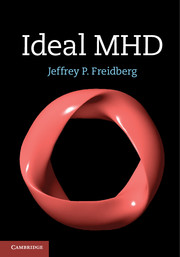Book contents
- Frontmatter
- Dedication
- Contents
- Preface
- Acknowledgements
- 1 Introduction
- 2 The ideal MHD model
- 3 General properties of ideal MHD
- 4 MHD equilibrium: general considerations
- 5 Equilibrium: one-dimensional configurations
- 6 Equilibrium: two-dimensional configurations
- 7 Equilibrium: three-dimensional configurations
- 8 MHD stability – general considerations
- 9 Alternate MHD models
- 10 MHD stability comparison theorems
- 11 Stability: one-dimensional configurations
- 12 Stability: multi-dimensional configurations
- Appendix A Heuristic derivation of the kinetic equation
- Appendix B The Braginskii transport coefficients
- Appendix C Time derivatives in moving plasmas
- Appendix D The curvature vector
- Appendix E Overlap limit of the high β and Greene–Johnson stellarator models
- Appendix F General form for q(ψ)
- Appendix G Natural boundary conditions
- Appendix H Upper and lower bounds on δQKIN
- Index
- References
2 - The ideal MHD model
Published online by Cambridge University Press: 05 July 2014
- Frontmatter
- Dedication
- Contents
- Preface
- Acknowledgements
- 1 Introduction
- 2 The ideal MHD model
- 3 General properties of ideal MHD
- 4 MHD equilibrium: general considerations
- 5 Equilibrium: one-dimensional configurations
- 6 Equilibrium: two-dimensional configurations
- 7 Equilibrium: three-dimensional configurations
- 8 MHD stability – general considerations
- 9 Alternate MHD models
- 10 MHD stability comparison theorems
- 11 Stability: one-dimensional configurations
- 12 Stability: multi-dimensional configurations
- Appendix A Heuristic derivation of the kinetic equation
- Appendix B The Braginskii transport coefficients
- Appendix C Time derivatives in moving plasmas
- Appendix D The curvature vector
- Appendix E Overlap limit of the high β and Greene–Johnson stellarator models
- Appendix F General form for q(ψ)
- Appendix G Natural boundary conditions
- Appendix H Upper and lower bounds on δQKIN
- Index
- References
Summary
Introduction
The goal of Chapter 2 is to provide a physical understanding of the ideal MHD model. Included in the discussion are (1) a basic description of the model, (2) a derivation starting from a more fundamental kinetic model, and, most importantly, (3) an examination of its range of validity.
In particular, it is shown that ideal MHD is the simplest fluid model that describes the macroscopic equilibrium and stability properties of a plasma. The claim of “simplest” is justified by a discussion of the large number of important plasma phenomena not covered by the model. However, in spite of its simplicity it is still a difficult model to solve analytically or even computationally because of the geometrical complexities associated with the two and three dimensionality of the configurations of fusion interest.
The derivation of the MHD model follows from the standard procedure of starting with a more fundamental and inclusive kinetic description of the plasma which describes the behavior of the electron and ion distribution functions. The mass, momentum, and energy moments of the kinetic equations are then evaluated. By introducing the characteristic length and time scales of ideal MHD, and making several corresponding ordering approximations, one is then able to close the system. The end result is the set of ideal MHD fluid equations.
- Type
- Chapter
- Information
- Ideal MHD , pp. 7 - 38Publisher: Cambridge University PressPrint publication year: 2014



